Having discovered Starryai.com last Friday evening, I’ve been playing with this system to see what its capabilities are as well as testing its limitations. My experience to date has taught me that the more specific the user is when writing the prompt that the AI artist uses to create its drawings, the more likely it is that the user will be happy with the results.
For many years I have been interested in creating a graphic novel set during the Victorian period. I like this period for many reasons. In addition to history, art, culture and fashion, I think this period appeals to my autistic sensibilities because the rules of social conduct were quite strict compared to the casual familiarity of our modern era. Since I do not have an innate understanding regarding how people interact; laws, district policy, school rules, social norms, Christian morality, and life experience have all helped to provide the social parameters within which I am able to function.
Although I admire the Victorian era, I would not have wanted to live during this time period. Unless one was white and at least middle class or higher, life during this era would not have been pleasant. In 1890 when the United States government began tracking employment hours, it was found that the average workweek for full time manufacturing employees was 100 hours. The average workweek for building tradesmen was 102 hours.
It would not be until 1938 that Congress would pass the Fair Labor Standards Act which limited the workweek to 44 hours, or 8.8 hours per day. By 1940, this law was amended to create the forty hour work week that we know today.
Pictured below is a historical photograph of a Victorian era sweatshop which shows children working at a textile mill.

Since I have long been interested in creating a graphic novel set during the Victorian period, last night I asked Starryai.com to produce “a Victorian daylight street scene in color. In the foreground passing from left to right is a cobblestoned street. On the other side of the street is a sidewalk that parallels the street. Beyond the street are grand Romanesque Revival-Style brownstone homes.”
This architectural style was a popular urban design that was found in both the United Kingdom and the United States. The look was inspired by 11th and 12th century European castles that had arched windows, turrets, columns, and a symmetrical facade.
Although this style originated in Germany during the early 19th century, it wasn’t popularized in the United States until 1870 when Boston architect Henry Hobson Richardson built the Buffalo State Asylum for the Insane, pictured below.

This architectural style proved to be so popular that it was used for the construction of civic buildings, churches, mansions, and brownstone houses. As with my earlier requests, the AI artist delivered a set of four pictures within 10 seconds. Here are my two favorite. Since I hadn’t specified the year, an early 20th century automobile may be seen in the picture, below right.

I then wrote the following prompt, “A colored picture from the perspective of standing outside the front door of a Romanesque Revival-style brownstone home.” While all four pictures were superb, the two below were my favorite. It should be noted that front doors during this time were used by family members and their guests. The domestic staff, (maid and cook as a minimum), would have had a separate basement entrance that would also have been used by tradesman and delivery drivers.
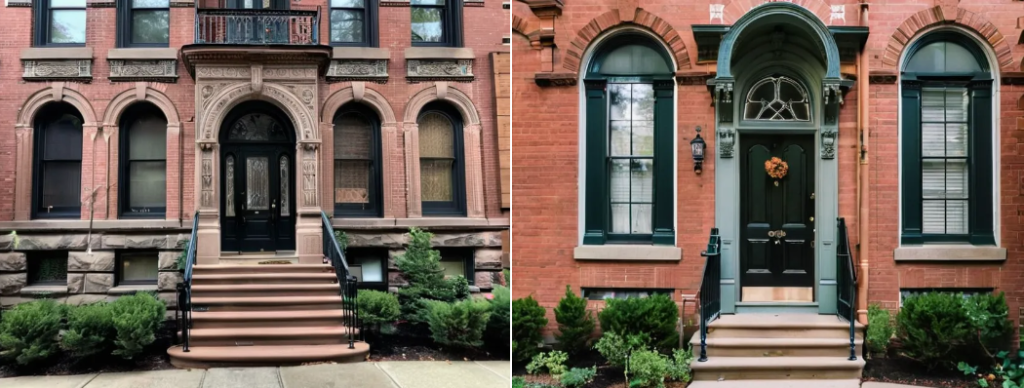
The front door would have opened onto a foyer. Pictured below is one of the AI generated foyers as seen from further within the house, looking towards the front door. Two of the other pictures that were created offered a similar theme. The system sadly bungled the fourth picture.

While I initially loved the look of the foyer below, particularly since it appeared to be showing the perspective as a guest would have seen the home from standing by the front door, the curving stairway to the right had issues and did not connect with the 2nd floor. The ceiling was also far too low and looked to only be a few inches above the top of the 2nd floor railing.

I wound up creating several more sets of pictures that included a parlor, dining room, upstairs hallway, study, and bedroom. All of the pictures were well done. The rooms were richly furnished in the upper middle class Victorian style which meant that there were a lot of patterns in the wallpaper, wall coverings, textiles, and tiled floors. There were decorative ceilings, borders on the walls, eclectic knick-knacks, often with jeweled tones, and lots of rich, vibrant colors throughout each room.
Since I liked the above image, I fixed it with 3D Paint. The process took about two hours.
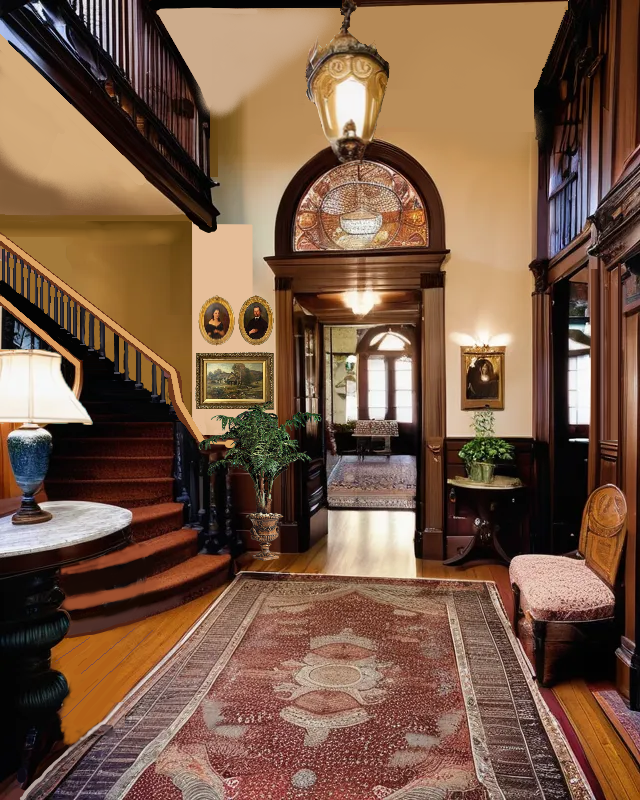
Pictured here are some of the other images that the AI created.
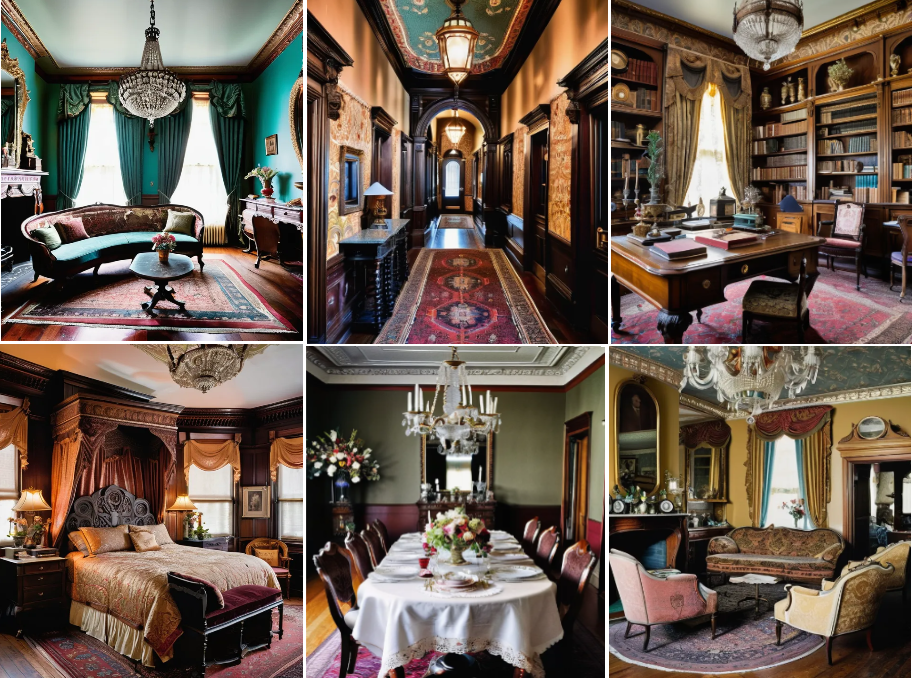
Sensing that I could likely create a digital novel using AI generated images, I began pushing the metaphorical envelope. I asked the system to create a train station’s waiting room for railway passengers. The system had a few problems.
Pictured below left is one of the images that was generated. While I loved the wooden seats as well as the decorative sky lighting, the faces of the figures were vague and indistinct. This was something I was able to use Paint 3D to correct as you may see in the picture, below right.
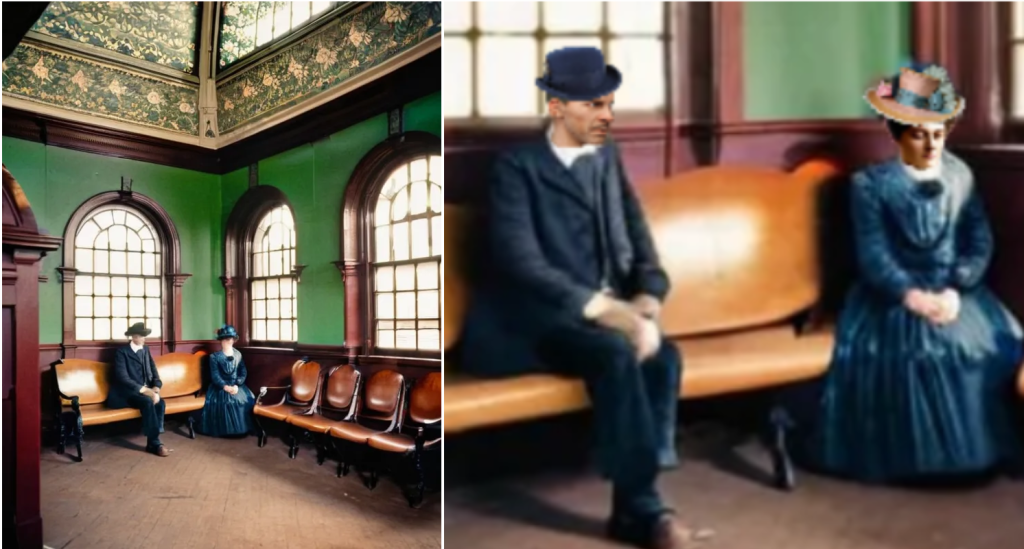
The revised image has been pictured below.
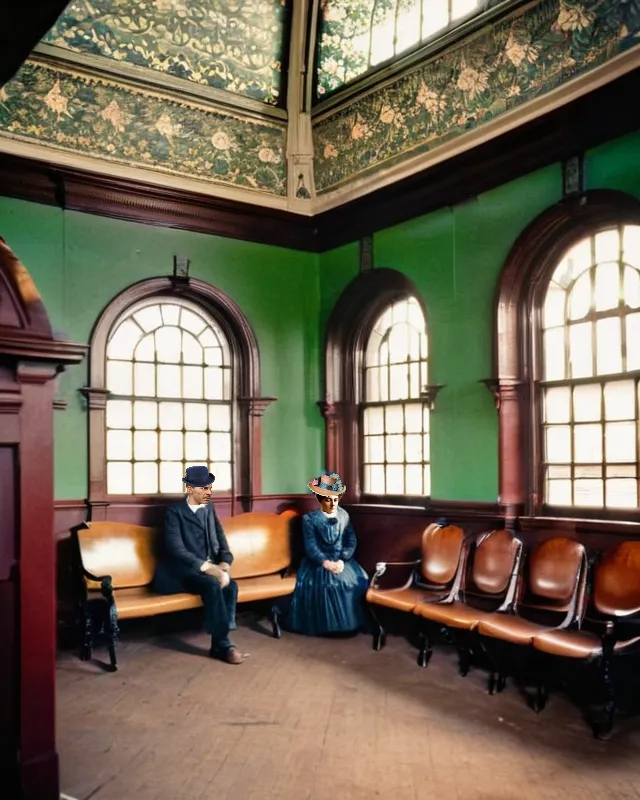
The image of the next passenger waiting room was more problematic. If you look closely, none of the seated passengers had any faces. In the front right foreground, a woman appears to be wearing some sort of gauze veil. If you were to progress further down this row of passengers b the time you reach the middle set, the heads look a bit like the round hat stands that a millinery, (hat maker) would use when decorating a woman’s hat.
In the background, lefthand side, is a vague outline of a headless figure. The three figures next to it look like scarecrow dummies that a farmer would prop in his or her field. The woman who is standing has a neck with a hat where the head should have been.
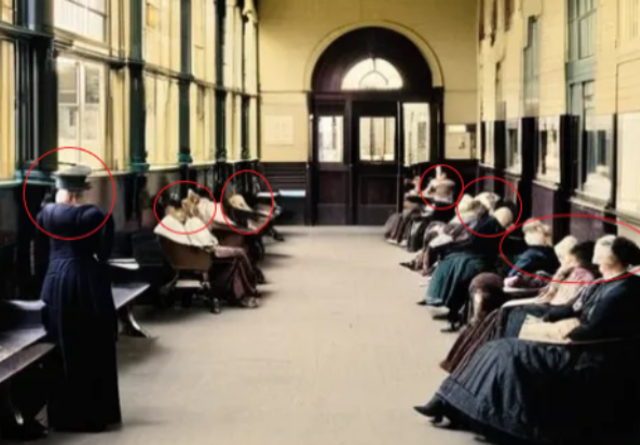
On the brighter side, when I asked the system to create a public lavatory for female railway passengers, all of the pictures that were generated were surprisingly acceptable. The AI artist gave me two pictures of restrooms with people and two that were empty.
As a sidenote, I will also say, “EWWWWW.” Although toilet paper was invented in 1857, there is no toilet paper in what is presumably a public stall in the picture, bottom left. Instead of toilet paper, there appears to be a towel. It looks as though the attendant in the green apron has just switched out the dirty gray towel with a fresh clean one.
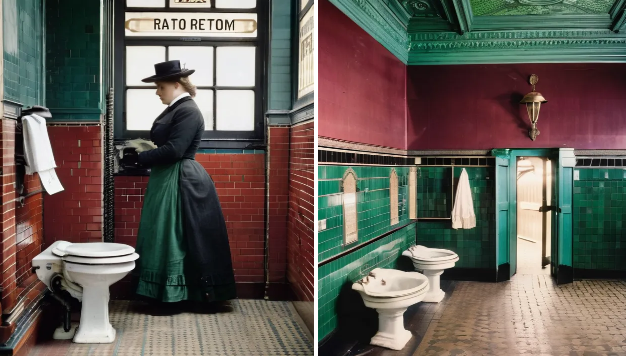
On the premise that this AI system works best when it’s given relatively simple prompts that aren’t overly complicated with too many people, doing too many things, I asked the system to create a 1st class lounge for an 1890’s British railway service.
There were at this time, roughly 10 competing railway lines in the United Kingdom. Each railway served a different regional area. Here is one of the passenger cars that was produced.

Depending upon the railway line in question, 1st class passenger service would have featured richly upholstered seats as opposed to hard wooden benches. There would have been carpeted floors, decorative ceilings, and some degree of service that at least have included tea given the limited gallies that would have been available on a train. Passengers would have also had access to private compartments. Long distance trains would have included the option sleeper cabins.
After having asked the AI artist to create the picture above, I had the system create two sets of people seated on wooden chairs. I also had it create one set of conductors. Excerpts from these three sets are pictured below.

I then used Corel PaintShop Pro 2022 to delete the background scenery. I subsequently used Cyberlink Power Directo 16 to superimpose these pictures into a railway passenger car.
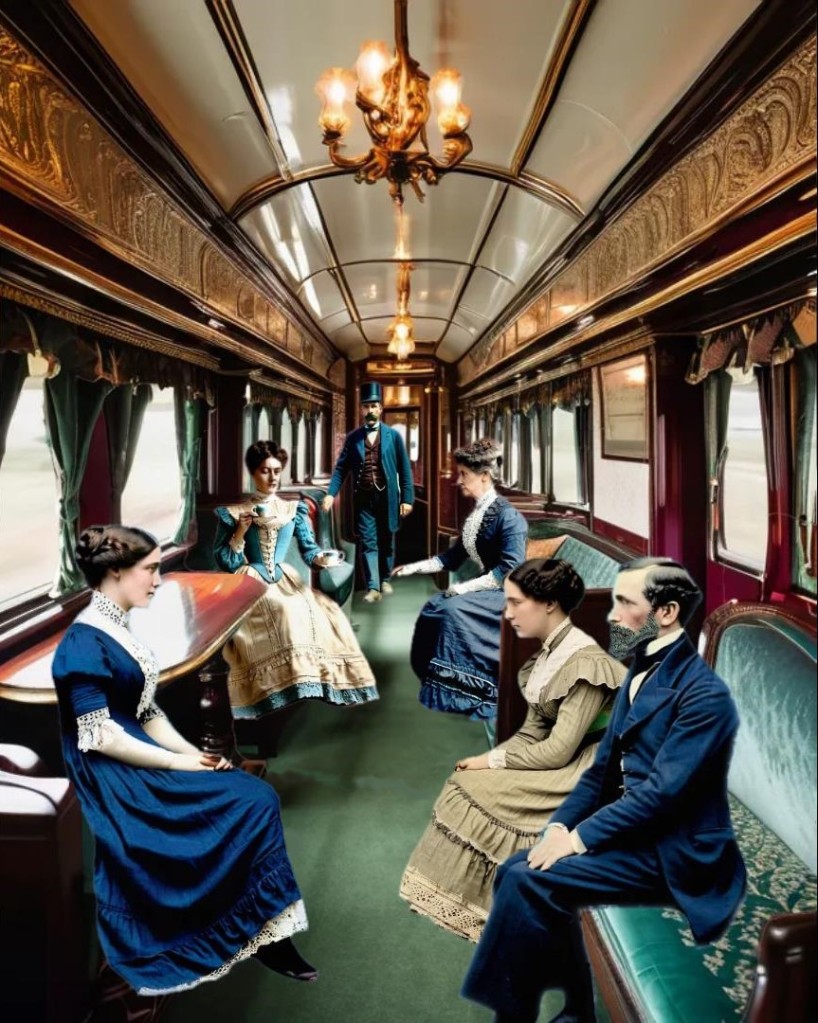
Since no respectable Victorian would have been seen outdoors without a hat, in the picture below I added a hat for each passenger. Each of these head coverings was created by the AI system. Since one of the ladies had a teacup in each hand, I put an elderly woman with an out stretched hand in the seat across the aisle. I subsequently put a teapot on a plate since it would not have done to have ruined the finish on the table by placing a hot kettle on top of the polished surface. The conductor in the background has also added a sense of movement.

As the weekend drew to a close, I had the AI system create a set of indigenous South American tribal warriors along with a female archeologist who was running for her life. The picture of the warrior with the blow gun (below – top left), had to be edited because he was blowing into the blowgun without having the weapon in his mouth.
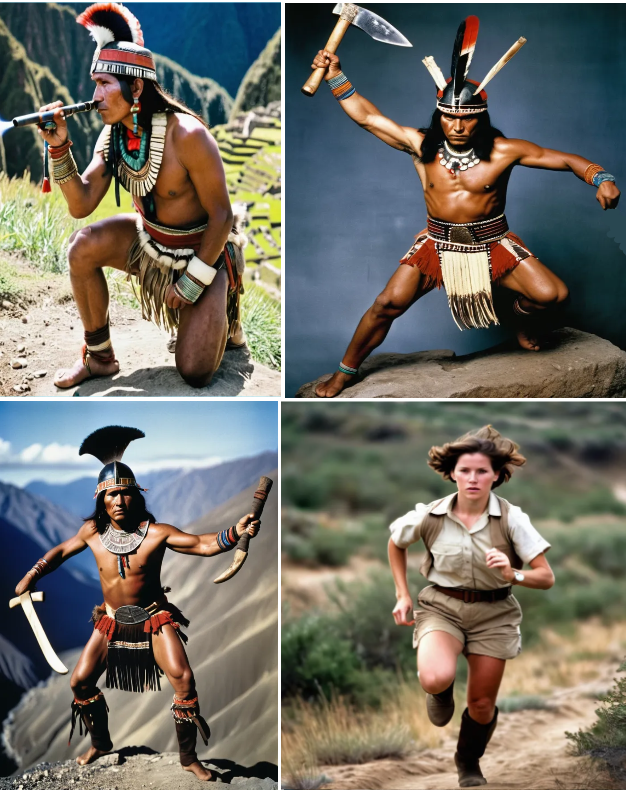
I then had the system create an Inca Temple and super imposed the above figures to create the composite image below.

All in all, I think AI has the potential to help me produce a graphic novel about an adventurer who triggers an Incan time portal that somehow sends her back to England in the 1890s.
While the use of a Phicen 1/6 scale action figure can be used to stage the protagonist in set poses albeit with a very limited wardrobe, the use of AI generated digital imagery could be used to affordably create background scenery and supporting characters.
I had hitherto been using copyright free digital images from Pexels which is a free service along with Dreamstime and Adobe which are both paid services. The use of AI will allow me to customize images as needed. This is one huge advantage that these other services do not (yet) offer.
While Starryai.com is not yet capable of creating complex pictures like the one above, it can (with carefully worded prompts) create the composite images that can then be used in conjunction with other imagery. As this AI system continues to accrue experience and to add to its database, it’s proficiency at creating images like the ones on this page will likely improve.
